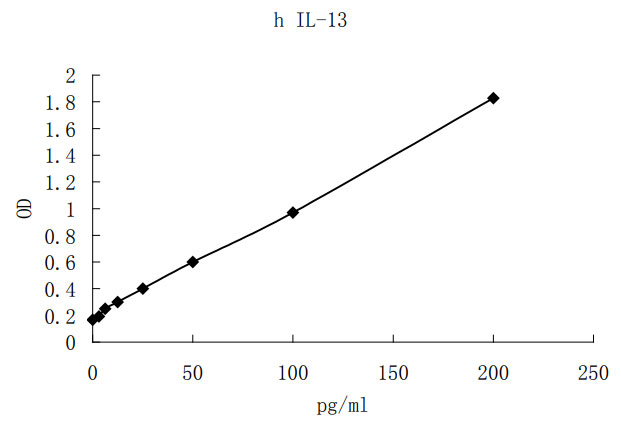Product Detail
Product NameHuman IL-13 ELISA kit
ApplicationsELISA
Species ReactivityHu
SpecificityNatural and recombinant Human IL-13 Ligand
Target NameHuman IL-13
Application Details
Detect Range: 3.125-200pg/ml
Sensitivity: 1pg/mL
Sample Type: Cell culture supernatant, serum, plasma (EDTA, citrate, heparin)
Sample Volume: 20 uL
Assay Time: 3 hours
Detection method: Colorimetric
Interleukin-13 (IL-13) is a 17 kDa immunoregulatory cytokine that plays a key role in the pathogenesis of allergy, cancer, and tissue fibrosis (1-3). It is secreted by Th1, Th2, Th17, NK, and mast cells, visceral smooth muscle cells, eosinophils, and basophils (2, 4). This pattern is similar to the expression of Interleukin-4 (IL-4) but also includes subsets of Th1 and Th17 cells that do not secrete IL-4 (5). IL-13 circulates as a monomer and has two internal disulfide bonds that contribute to its bundled four α-helix configuration (6, 7). Mature human IL-13 shares approximately 58% amino acid sequence identity with mouse and rat IL-13. Despite the low homology, it exhibits cross-species activity between human, mouse, and rat (8, 9). IL-13 suppresses the production of proinflammatory cytokines and other cytotoxic substances by macrophages, fibroblasts, and endothelial cells. On B cells, it promotes cellular activation, immunoglobulin class switching to IgE, and the upregulation of CD23/Fcε RII. Polymorphisms and upregulation of IL-13 are associated with atopy, asthma, airway hyperresponsiveness, and tissue fibrosis (1, 10).
The biological effects of IL-13 and IL-4 are closely related due in part to a shared receptor system. IL-13 binds with low affinity to the transmembrane IL-13 Rα1 which then forms a signaling complex with the transmembrane IL-4 Rα (11-13). This high affinity receptor complex also functions as the type 2 IL-4 receptor (11, 12). Soluble forms of IL-4 Rα are expressed which retain ligand binding properties and inhibit IL-4 bioactivity (14, 15). IL-4 Rα also associates with the common gamma chain (γc) to form the type 1 IL-4 receptor complex (16, 17).
Additionally, IL-13 binds with high affinity to IL-13 Rα2 which is expressed as cell surface and soluble forms (18-20). IL-13 Rα2 functions as a decoy receptor by preventing IL-13 from signaling through the IL-13 Rα1/IL-4 Rα complex (21, 22). It also inhibits responsiveness to IL-4 by blocking signaling through IL-4-occupied IL-13 Rα1/IL-4 Rα receptor complexes (22, 23). IL-13 Rα2 is upregulated during Th2-biased immune responses and limits inflammatory tissue damage (20, 24, 25). Aside from its decoy function, IL-13 Rα2 can signal in response to IL-13 to directly promote tumor cell invasiveness and the development of tissue fibrosis (26-28).



 YES
YES



